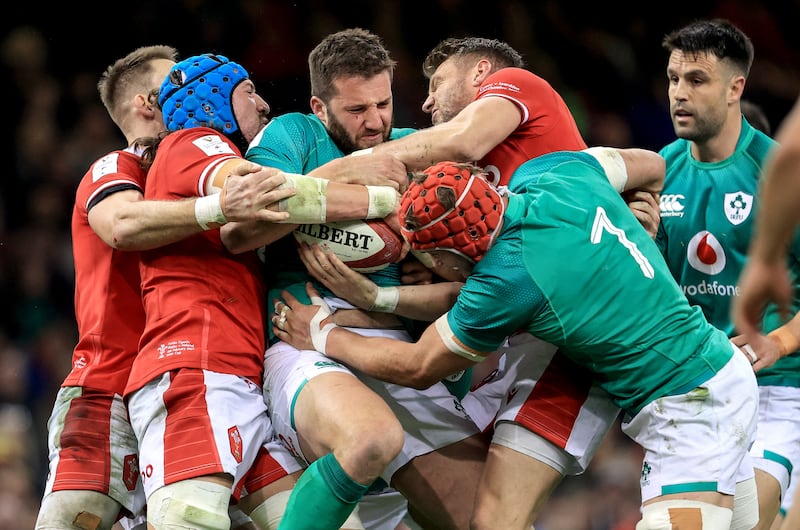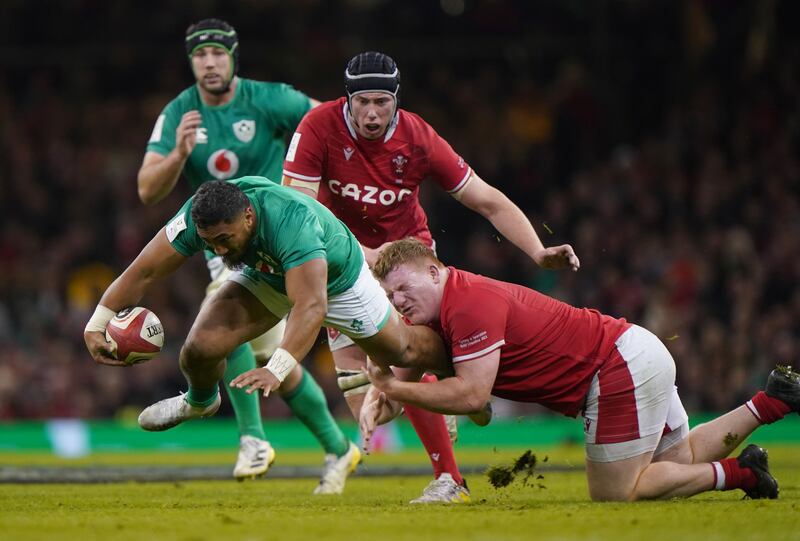Someone once said that you don’t have to be great to start but that at some point you do have to start to be great in succeeding at elite level.
It wasn’t a direct sporting metaphor or maxim, but the sentiment sprang to mind when watching Stuart McCloskey at the Principality stadium and considering his Ireland career to date. From his first cap almost seven years ago, to sporadic involvement against Tier 2 nations, it was hardly an orthodox rite of passage to be front and centre in world rugby’s number one side.
Opportunity knocked last autumn, and McCloskey answered Ireland’s call. Three consecutive appearances in the run-on team during the November Test series enabled him to retain the jersey for the fourth time in succession in the opening Six Nations match in Cardiff.
Robbie Henshaw’s injury, Bundee Aki’s recent six-week playing sabbatical and McCloskey’s form in the Tests against South Africa, Fiji and Australia had persuaded Ireland head coach Andy Farrell to choose the services of the Ulster centre ahead of other options that included the uncapped, in-form Leinster centre Jamie Osborne.
For those that cite the 21-year-old Osborne’s relative youth and lack of experience, the Welsh inside centre who directly opposed McCloskey, Joe Hawkins, is 20, had one cap before Saturday and yet was arguably his team’s best player in the 34-10 defeat.
Farrell’s decision was understandable. McCloskey (30) had been outstanding in the 26 minutes he managed against the Springboks before injury forced him to the sideline, translating the high-calibre contribution that was characteristic of his pomp at Ulster into the green jersey.
He made an amazing recovery to play against Fiji and then the Wallabies without quite matching the effervescence, however short lived, from the South African game. That was the nub of the challenge he faced going to Cardiff.
McCloskey had to discover a way to unleash the game-shaping influence of which he is capable, while ignoring some external dialogue. If some people feel that he is keeping the jersey warm until Henshaw returns, or Aki musters enough match minutes, or Osborne is deemed ready to step up, then that is their prerogative.

The only relevant rebuttal McCloskey can offer is his performance. It is not about standing out and being maverick in style and substance for the sake of it, a self-indulgence that might compromise the team requirements, rather it entails adding conspicuous value when opportunities arise. Solid won’t cut it, especially for a specialist ostensibly limited to one position.
When tossing a rugby CV into the mix, versatility is a prized asset, even if mastery of one role is more prized by coaches than being a jack of all trades. .
Cardiff was to be McCloskey’s latest proving ground, the chance that all players claim to crave, and he couldn’t have started in more eye-catching fashion, a beautifully flighted, long cut-out pass sending James Lowe scampering down the wing. That moment was the genesis of Ireland’s first try.
At 6ft 4in and 17 stone, McCloskey was hidden by Ireland in plain sight, initially used as a decoy in the hope that his presence would get the Welsh defence to hunker down in anticipation of his arrival and the impending physical challenge on the gainline, thereby providing space and time for his team-mates. As a gambit it worked.
It wasn’t until the 15th minute that Stu did a Stu thing and thundered into three Welsh tacklers taking play north of the gainline and giving his team front-foot possession. Two minutes later, though, he was reminded that there is a sequence to being able to offload in a tackle, one that can be fatally compromised by being too upright in contact.
As the first quarter slipped into the second and Wales enjoyed a little purchase in the Irish 22, Garry Ringrose made a brilliant try-saving tackle, shortly followed by another from his midfield partner.

Having screamed for Johnny Sexton to squeeze the distance between them on the open side from a Welsh put-in at a scrum, McCloskey made the tackle that felled the hard-charging Hawkins a short hop from the Irish line.
Ireland continued to use him sparingly but there was another moment on 29 minutes in which he ploughed through a redshirted human wall and offloaded to the supporting Murray. On 60 minutes Farrell summoned Aki and the non-scientific equation that ensued was whether McCloskey’s 60 minutes rated higher than Aki’s 20.
An answer may come in the form of team selection for next Saturday’s game against France at the Aviva Stadium. McCloskey’s numbers were pretty good, though, nine carries for 66 metres, eight tackles, one missed, one offload, three tackles broken and two defenders beaten.
[ Wales v Ireland player ratings: Keenan, Sheehan and Doris lead the way in CardiffOpens in new window ]
The optics were no less positive, even if they did require closer scrutiny to pick up some of the nuances of the performance. Even if the Lions are circling in the form of a soon-to-be fit Henshaw and Aki, McCloskey, based on the coach’s established pecking order and performance, deserves to keep the 12 jersey for the French match.
He must though start to be great if he wants to keep that primacy because in a position where the competition is world class, being good will not suffice. The Test match training wheels are off; time for him to light up that arena with his talent. Next Saturday would be timely to start that process.






